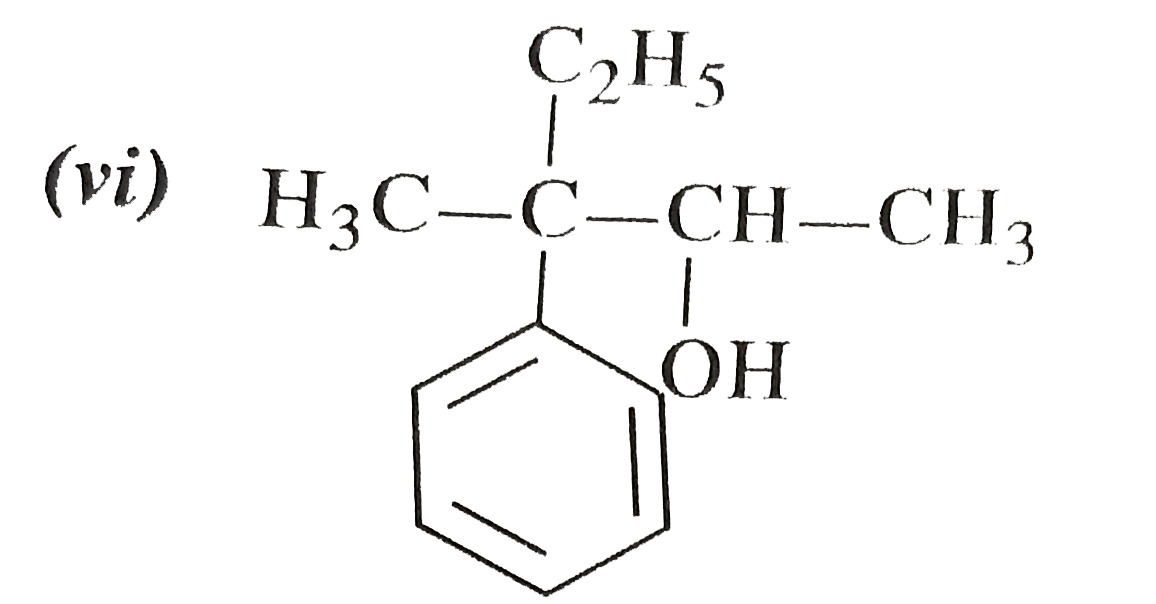Comment on the following reactions
(i) CH3OH+NaCl→ (ii) CH3OH+HCl→
Both reactions take place easily.
Only reaction (ii) takes place.
Reaction (ii) takes places faster than (i).
None of the two reactions in possible.
The correct Answer is:B
To comment on the reactions provided, we will analyze each reaction step by step.
Reaction (i): CH3OH+NaCl
1. Identify the Reactants: The reactants are methanol (CH3OH) and sodium chloride (NaCl).
2. Dissociation of NaCl: Sodium chloride dissociates in solution to form Na⁺ and Cl⁻ ions.
3. Nature of Methanol: Methanol has a hydroxyl (-OH) group, which is polar. The oxygen atom in the -OH group is partially negative, making it a nucleophilic site.
4. Nucleophilic Attack: The Cl⁻ ion could potentially attack the carbon atom of methanol, but the -OH group is not a good leaving group.
5. Leaving Group Consideration: For a nucleophilic substitution reaction to occur, there must be a good leaving group. The hydroxyl group (-OH) is not a good leaving group because it is a strong base and does not leave easily.
6. Conclusion for Reaction (i): Therefore, no reaction occurs between methanol and sodium chloride.
Reaction (ii): CH3OH+HCl
1. Identify the Reactants: The reactants are methanol (CH3OH) and hydrochloric acid (HCl).
2. Dissociation of HCl: Hydrochloric acid dissociates in solution to produce H⁺ and Cl⁻ ions.
3. Protonation of Methanol: The H⁺ ion from HCl can protonate the -OH group of methanol, forming CH3OH2⁺ (oxonium ion).
4. Formation of a Good Leaving Group: The protonated form (CH3OH2⁺) has water (H2O) as a leaving group, which is a much better leaving group than hydroxide (OH⁻).
5. Nucleophilic Attack by Cl⁻: The Cl⁻ ion can now act as a nucleophile and attack the carbon atom of the oxonium ion (CH3OH2⁺).
6. Formation of Product: This results in the formation of methyl chloride (CH3Cl) and water.
7. Conclusion for Reaction (ii): Thus, the reaction between methanol and hydrochloric acid does occur, resulting in the formation of methyl chloride.
Final Comments:
- Reaction (i) does not occur due to the poor leaving group (OH⁻).
- Reaction (ii) occurs and leads to the formation of methyl chloride.
Summary:
- Reaction (i): No reaction occurs.
- Reaction (ii): Reaction occurs, producing CH3Cl.
2. Dissociation of NaCl: Sodium chloride dissociates in solution to form Na⁺ and Cl⁻ ions.
3. Nature of Methanol: Methanol has a hydroxyl (-OH) group, which is polar. The oxygen atom in the -OH group is partially negative, making it a nucleophilic site.
4. Nucleophilic Attack: The Cl⁻ ion could potentially attack the carbon atom of methanol, but the -OH group is not a good leaving group.
5. Leaving Group Consideration: For a nucleophilic substitution reaction to occur, there must be a good leaving group. The hydroxyl group (-OH) is not a good leaving group because it is a strong base and does not leave easily.
6. Conclusion for Reaction (i): Therefore, no reaction occurs between methanol and sodium chloride.
2. Dissociation of HCl: Hydrochloric acid dissociates in solution to produce H⁺ and Cl⁻ ions.
3. Protonation of Methanol: The H⁺ ion from HCl can protonate the -OH group of methanol, forming CH3OH2⁺ (oxonium ion).
4. Formation of a Good Leaving Group: The protonated form (CH3OH2⁺) has water (H2O) as a leaving group, which is a much better leaving group than hydroxide (OH⁻).
5. Nucleophilic Attack by Cl⁻: The Cl⁻ ion can now act as a nucleophile and attack the carbon atom of the oxonium ion (CH3OH2⁺).
6. Formation of Product: This results in the formation of methyl chloride (CH3Cl) and water.
7. Conclusion for Reaction (ii): Thus, the reaction between methanol and hydrochloric acid does occur, resulting in the formation of methyl chloride.
- Reaction (ii) occurs and leads to the formation of methyl chloride.
- Reaction (i): No reaction occurs.
- Reaction (ii): Reaction occurs, producing CH3Cl.
Topper's Solved these Questions
- BOOK - DISHA PUBLICATIONCHAPTER - HALOALKANES AND HALOARENES EXERCISE - Exercise-1:Concept Builder(Topicwise)(TOPIC 3:)(Preparation and Properties of Halorenes)7videos
HALOALKANES AND HALOARENES
- BOOK - DISHA PUBLICATIONCHAPTER - HALOALKANES AND HALOARENES EXERCISE - Exercise-1:Concept Builder(Topicwise)(TOPIC 4)(Some Important Polyhalogen Compounds)13videos
HALOALKANES AND HALOARENES
- BOOK - DISHA PUBLICATIONCHAPTER - HALOALKANES AND HALOARENES EXERCISE - Exercise-1:Concept Builder(Topicwise)(TOPIC 1:)(General Characteristics of Haloakanes and Halorenes)9videos
HALOALKANES AND HALOARENES
- BOOK - DISHA PUBLICATIONCHAPTER - GENERAL PRINCIPLES AND PROCESSES OF ISOLATION OF ELEMENTSEXERCISE - EXERCISE -1: CONCEPT APPLICATOR35videos
GENERAL PRINCIPLES AND PROCESSES OF ISOLATION OF ELEMENTS
- BOOK - DISHA PUBLICATIONCHAPTER - HYDROCARBONSEXERCISE - EXERCISE -2 CONCEPT APPLICATOR29videos
HYDROCARBONS
Similar Questions
Knowledge Check
- Question 1 - Select One
For the following reaction, A is
CH3 |Ph−MgBr+CH3−C−OH→A | CH3A B
B C
C D
D
- Question 2 - Select One
In the sequence of following reactions : CH3OHHI−−→CH3IKCN−−→CH3CNReduction−−−−−→XHNO2−−−→Y,X and Y are respectively
ACH3CH2NH2andCH3CH2OHBCH3CH2NH2andCH3COOHCCH3CH2OHandCH3CHODCH3OCH3andCH3CHO - Question 3 - Select One
The product which is not formed in the following reactions :
CH3 CH3 | | Ph−C−CH−CH−CH−CH2OHHIO4(excess)−−−−−−−→ | | | OH OH OHAHCOOHBPh−O∣∣C−CH3COHC−CH3∣CH−CH2OHDOHC−CH3∣CH−CHO
Name the reagents used in the following reactions:
(i) CH3−CHO?−−→CH3−CH∣OH−CH3 (ii) CH3−COOH?−−→CH3−COClView SolutionThe number of alcohols giving iodoform test among the following is:
CH3CH2OH,CH3OH,CH3CH2CH2OH,(CH3)2(CHOH),CH3CH3CH2CH2OH
CH3CH2CH(OH)CH3,CH3CH(OH)CH(CH3)2(C2H5)2CHOH,(CH3)3COHView SolutionExplain the formation of the products in the following reaction.
CH3CH=CHCH2Br+H2O→CH3CH=CHCH2OH+CH3CH(OH)CH=CH2.View SolutionGive the IUPAC names of the following compounds:
(i)C6H5−CH2−CH2−OH (ii)CH3−CH3∣C∣CH3−CH2−CH2−OH
(iii)[(CH3)2CH]3COH. (iv)CH3−CH∣OH−CH2−CH2−O−CH2CH3
(v)CH3−CH2−CH∣Cl−CH∣CH3−CH3∣C∣OH−CH3 (vi)
(vii)(CH3)3COH (viii)CH3−CH∣CH3−CH∣OH−CH2−CH∣CH3−CH3
(ix) CH2OH |CH2−CH2−CH−CH−CH−CH3 | | CH2Cl CH3, (x) CH3−C=C−CH2OH | | CH3Br
(xi) CH2=CH−CH∣OH−CH2−CH3, (xii) CH2OH |CH3−CH−CH2−CH−CH−CH3 | | CH3 OHView SolutionGive the names of the following compounds :
(i)CH3−CH2−CH2−CH(OH)−CH3
(ii) CH3−CH2−CH2−COOHView Solution

